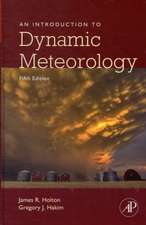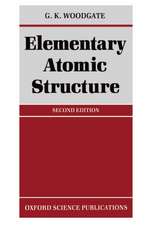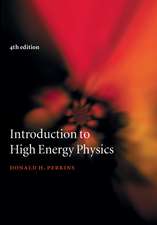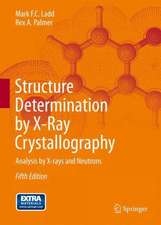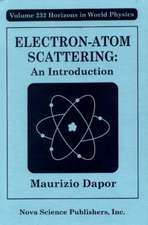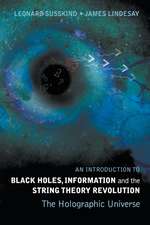Disordered Materials: An Introduction
Autor Paolo Ossien Limba Engleză Paperback – 14 mar 2012
Preț: 642.83 lei
Preț vechi: 756.27 lei
-15% Nou
Puncte Express: 964
Preț estimativ în valută:
122.100€ • 128.44$ • 101.57£
122.100€ • 128.44$ • 101.57£
Carte tipărită la comandă
Livrare economică 15-29 aprilie
Preluare comenzi: 021 569.72.76
Specificații
ISBN-13: 9783642067389
ISBN-10: 3642067387
Pagini: 344
Ilustrații: XII, 329 p. 210 illus.
Dimensiuni: 155 x 235 x 18 mm
Greutate: 0.49 kg
Ediția:Second Edition 2006
Editura: Springer Berlin, Heidelberg
Colecția Springer
Locul publicării:Berlin, Heidelberg, Germany
ISBN-10: 3642067387
Pagini: 344
Ilustrații: XII, 329 p. 210 illus.
Dimensiuni: 155 x 235 x 18 mm
Greutate: 0.49 kg
Ediția:Second Edition 2006
Editura: Springer Berlin, Heidelberg
Colecția Springer
Locul publicării:Berlin, Heidelberg, Germany
Public țintă
ResearchCuprins
Platonic Solids: Geometry and Symmetry.- Structural Order.- The Glass Transition.- The Structure of Disordered Systems.- Clusters.- Quasicrystals.
Recenzii
From the reviews of the second edition:
The text is clearly presented, amply illustrated and has approximately 45 references with an equivalent amount of further reading…it provides a fresh viewpoint which makes it well worth careful reading….it provides a stimulating and novel coverage of a difficult subject area.
--Glass Technology
"The book is an overview of various models of disordered condensed materials. … the book covers successively glass transition, structure of disordered systems, atomic clusters and quasicrystals. The book (intended to readers with a good physics background) is easy to read, it is self-contained, and displays many theoretical and experimental illustrative results." (Guy Jumarie, Zentralblatt MATH, Vol. 1145, 2008)
The text is clearly presented, amply illustrated and has approximately 45 references with an equivalent amount of further reading…it provides a fresh viewpoint which makes it well worth careful reading….it provides a stimulating and novel coverage of a difficult subject area.
--Glass Technology
"The book is an overview of various models of disordered condensed materials. … the book covers successively glass transition, structure of disordered systems, atomic clusters and quasicrystals. The book (intended to readers with a good physics background) is easy to read, it is self-contained, and displays many theoretical and experimental illustrative results." (Guy Jumarie, Zentralblatt MATH, Vol. 1145, 2008)
Notă biografică
Paolo M. OSSI (born in Milan, 1953) PhD in Solid State Physics, is Associate Professor of Physics of Matter at the Dipartimento di Ingegneria Nucleare, Politecnico di Milano. His current research interests include the structure of metastable condensed systems, the interaction between energetic photon and particle beams and solids, the properties (in particular structural and mechanical) of thin films, both metallic and ceramic, deposited in the presence of energetic beams. Paolo M. Ossi is author, or co-author of more than 100 scientific papers, besides many contributions to international Conferences, Workshops and Symposia.
Textul de pe ultima copertă
This self-contained text introduces the physics of structurally disordered condensed systems at the level of advanced undergraduate and graduate students. Among the topics are the geometry and symmetries of the structural units used as building blocks of extended structures, the various kinds of disorder, the phenomenology and the main theories of the glass transition, the structure of amorphous systems and the techniques to investigate it, the evolution of system's structure with its size (clusters) and the presence of orientational order in the absence of translational order (quasicrystals). In the second edition, the treatment of the mode coupling theory of the glass transition has been enlarged and connects now to a new section on collective excitations in disordered systems. Special attention has been devoted to nanometer-sized disordered systems, with emphasis on cluster-assembled materials. Questions of what governs the occurrence and stability of quasicrystals, the features of the amorphous to quasicrystal transformation and its reverse transition are discussed. The conditions leading to nano-quasicrystalline phases of technological interest are examined. Throughout the text relevant recent experimental and theoretical results are discussed so as to give readers insight into the currently most vibrant research topics.
From the reviews of the first edition: "The text is clearly presented, amply illustrated and has approximately 45 references with an equivalent amount of further reading [...] it provides a fresh viewpoint which makes it well worth careful reading... [and] provides a stimulating and novel coverage of a difficult subject area." Glass Technology
From the reviews of the first edition: "The text is clearly presented, amply illustrated and has approximately 45 references with an equivalent amount of further reading [...] it provides a fresh viewpoint which makes it well worth careful reading... [and] provides a stimulating and novel coverage of a difficult subject area." Glass Technology
Caracteristici
Discusses disorder and its importance in materials science from a general theoretical point of view and as a means of explaining experimentally observed properties Clearly presented, amply illustrated and has approximately 45 references with an equivalent amount of further reading Provides a fresh viewpoint which makes it well worth careful reading Provides a stimulating and novel coverage of a difficult subject area Includes supplementary material: sn.pub/extras


